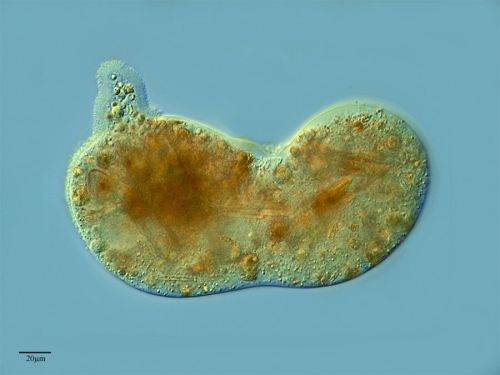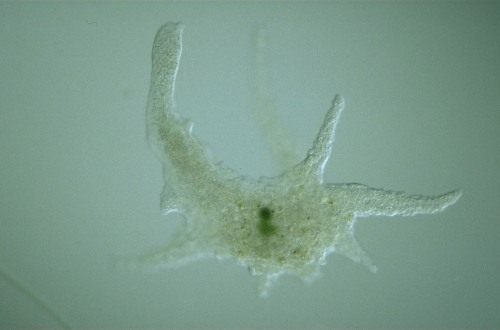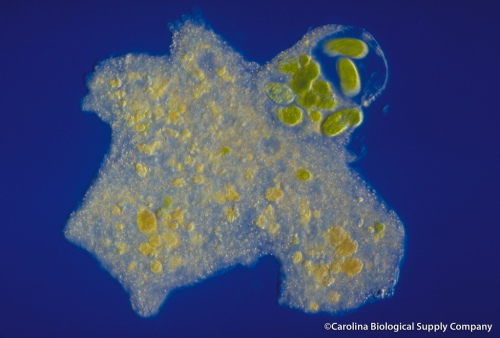by Piter Kehoma Boll
It’s time to dig deep into the mud again and bring up a peculiar protist, the third species of the clade Amoebozoa to be featured here. Its binomial name is Pelomyxa palustris, and I decided to call it the common pelomyxa.
Measuring up to 5 mm in length, although usually having less than 1 mm, the common pelomyxa is considered a “giant amoeba”. In fact, the Giant Amoeba Chaos carolinense, previously featured here, was once classified in the genus Pelomyxa, but currently we know that they are not closely related at all. While the true giant amoebas of the genus Chaos are closely related to the common amoebas of the genus Amoeba, the species in Pelomyxa belong to a completely different group of amoebas.

A specimen of the common pelomyxa. The large pseudopod is to the right and the small uroid can be seen projecting from the cell at the upper left. Credits to Proyecto Agua.*
The cell of the common pelomyxa has a somewhat cylindrical shape with a single, large, semicircular pseudopod at the front, thus moving basically always in the same direction, forward, differently from the more classical amoebas with several pseudopods and the ability to move in any direction. At the opposite side of the cell, the common pelomyxa has a small, also semicircular appendix called the uroid that is covered by several small non-motile flagella. The flagella are surrounded by small cytoplasmic projections (villi) that are easily seen under the microscope.
The common pelomyxa lives buried in the sediments of freshwater lakes throughout the northern hemisphere, especially those rich in decaying organic matter. It slides through the mud while feeding on smaller microorganisms and organic debris. Such an environment is characterized by the complete absence or extremely low concentrations of oxygen. As a result, the common pelomyxa is anaerobic and even lacks mitochondria. For this reason, it was once considered part of a very primitive group of eukaryotes that diverged before the incorporation of the endosymbiotic bacteria that would evolve into mitochondria. Currently, however, it is known that their lack of mitochondria is actually due to a secondary loss and they seem to be related to true amoebas and slime molds.
More than only lacking mitochondria, the cell of the common pelomyxa has a lot of peculiar features. Depending on the size of the cell, it may contain a few to several hundred nuclei. The cytoplasm also appears to lack several typical eukaryotic organelles, such as the Golgi apparatus and the endoplasmic reticulum. There are, however, many, many small vacuoles, so many that the cell usually has a foamy appearance.
Endosymbiotic bacteria are also found in great numbers in the cytoplasm of the common pelomyxa. After several years of research, it seems that these bacteria are obligate symbionts. Perhaps they help this strange amoeba to perform some of the tasks that should be done by the several organelles that it lacks.
– – –
– – –
References:
Goodkov, A. V.; Chistyakova, L. V.; Seravin, L. N.; Frolov, A. O. (2004) The concept of pelobionts (Class Peloflagellatea): Brief history and current state. Entomological Review 84(Suppl. 2): S10–S20.
Wikipedia. Pelomyxa. Available at < https://en.wikipedia.org/wiki/Pelomyxa >. Access on May 26, 2018.
– – –
*
This work is licensed under a Creative Commons Attribution-NonCommercial-ShareAlike 2.0 Generic License.




